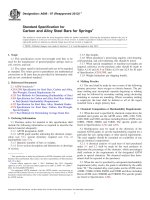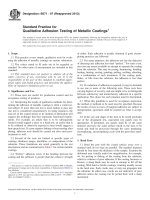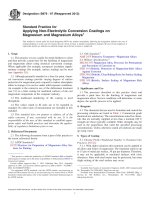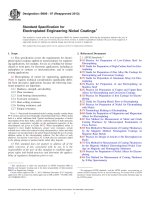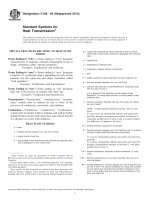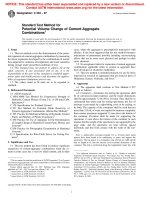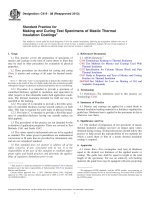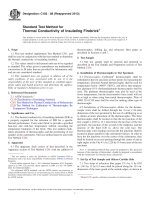Astm c 416 97 (2013)
Bạn đang xem bản rút gọn của tài liệu. Xem và tải ngay bản đầy đủ của tài liệu tại đây (51.36 KB, 2 trang )
Designation: C416 − 97 (Reapproved 2013)
Standard Classification of
Silica Refractory Brick1
This standard is issued under the fixed designation C416; the number immediately following the designation indicates the year of
original adoption or, in the case of revision, the year of last revision. A number in parentheses indicates the year of last reapproval. A
superscript epsilon (´) indicates an editorial change since the last revision or reapproval.
1. Scope
3. Significance and Use
1.1 This classification is limited to silica brick meeting the
following requirements:
Alumina (Al2O3) content of less than 1.50 %.
Titania (TiO2) content of less than 0.20 %.
Iron oxide (FeO3) content of less than 2.50 %.
Calcium oxide (CaO) content of less than 4.00 %.
Average modulus of rupture of not less than 500 psi (3.45
MPa).
3.1 The presence of certain impurities in silica brick tends to
lower their refractoriness and service limits. This classification
permits those familiar with refractories to predict the refractoriness of silica brick from their alkali and alumina contents.
1.2 This standard does not purport to address all of the
safety concerns, if any, associated with its use. It is the
responsibility of the user of this standard to establish appropriate safety and health practices and determine the applicability of regulatory limitations prior to use.
4.2 Types:
4.2.1 Type A—Silica brick having a flux factor of 0.50 or
less.
4.2.2 Type B—All other silica brick falling within the scope
of this classification.
2. Referenced Documents
5. Test Methods
4. Basis of Classification
4.1 Flux Factor —Silica brick are classified on the basis of
impurities by the use of a “flux factor,” which is equal to the
percent of alumina plus twice the percent of total alkalies.
2.1 ASTM Standards:2
C133 Test Methods for Cold Crushing Strength and Modulus of Rupture of Refractories
5.1 The properties listed in this classification shall be
determined in accordance with the following ASTM methods:
5.1.1 Modulus of Rupture—Test Method C133.
5.1.2 Chemical Analysis—XRF and ICP.
NOTE 1—Chemical analysis of refractory products is determined by a
combination of x-ray fluorescence (XRF) and inductively coupled plazma
(ICP) using standard reference materials (SRM), including various types
of minerals and refractory materials that are available from the National
Institute of Standards and Technology3 and other appropriate sources.
6. Retests
6.1 Because of variables resulting from sampling and the
lack of satisfactory reproducibility in tests conducted by
different laboratories, the material may be resampled and
retested when requested by either the manufacturer or the
purchaser. This may apply in instances when the first test
results do not conform to the requirements prescribed in this
classification. The final results to be used shall be the average
of at least two sets of results, each of which has been obtained
by following in detail the specified testing procedures.
1
This classification is under the jurisdiction of ASTM Committee C08 on
Refractories and is the direct responsibility of Subcommittee C08.92 on The Joseph
E. Kopanda Subcommittee for Editorial, Terminology and Classification.
Current edition approved Sept. 1, 2013. Published September 2013. Originally
approved in 1958. Last previous edition approved in 2007 as C416 – 97 (2007).
DOI: 10.1520/C0416-97R13.
2
For referenced ASTM standards, visit the ASTM website, www.astm.org, or
contact ASTM Customer Service at For Annual Book of ASTM
Standards volume information, refer to the standard’s Document Summary page on
the ASTM website.
3
Available from National Institute of Standards and Technology (NIST), 100
Bureau Dr., Stop 1070, Gaithersburg, MD 20899-1070, .
7. Keywords
7.1 brick; refractories; silica
Copyright © ASTM International, 100 Barr Harbor Drive, PO Box C700, West Conshohocken, PA 19428-2959. United States
1
C416 − 97 (2013)
ASTM International takes no position respecting the validity of any patent rights asserted in connection with any item mentioned
in this standard. Users of this standard are expressly advised that determination of the validity of any such patent rights, and the risk
of infringement of such rights, are entirely their own responsibility.
This standard is subject to revision at any time by the responsible technical committee and must be reviewed every five years and
if not revised, either reapproved or withdrawn. Your comments are invited either for revision of this standard or for additional standards
and should be addressed to ASTM International Headquarters. Your comments will receive careful consideration at a meeting of the
responsible technical committee, which you may attend. If you feel that your comments have not received a fair hearing you should
make your views known to the ASTM Committee on Standards, at the address shown below.
This standard is copyrighted by ASTM International, 100 Barr Harbor Drive, PO Box C700, West Conshohocken, PA 19428-2959,
United States. Individual reprints (single or multiple copies) of this standard may be obtained by contacting ASTM at the above
address or at 610-832-9585 (phone), 610-832-9555 (fax), or (e-mail); or through the ASTM website
(www.astm.org). Permission rights to photocopy the standard may also be secured from the ASTM website (www.astm.org/
COPYRIGHT/).
2
